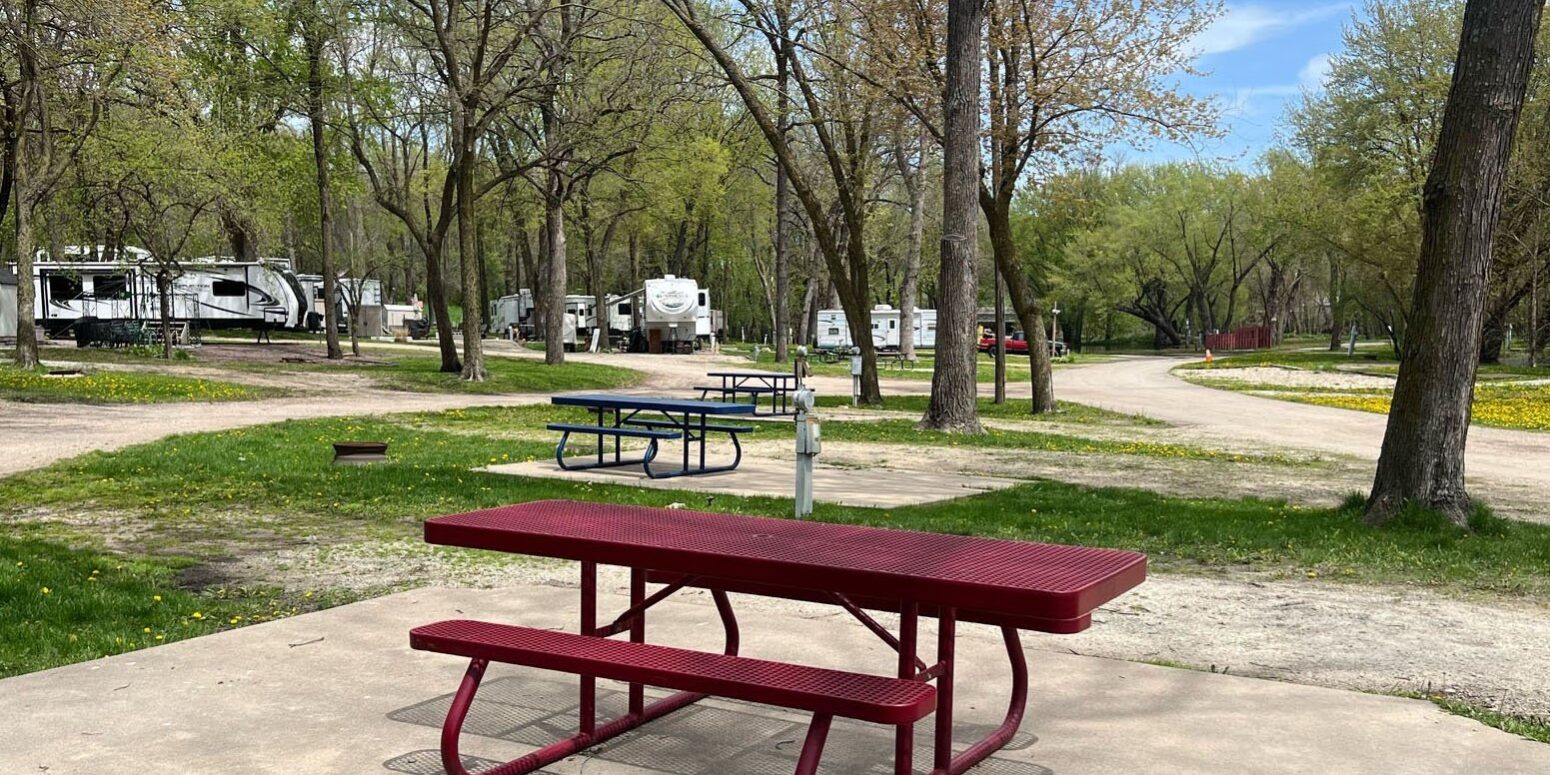Designing campgrounds to ensure usability and accessibility is key to creating enjoyable experiences for all visitors. Proper placement of picnic tables is a vital part of this process. Whether you’re outfitting a new campground or upgrading an existing one, following best practices for accessibility ensures compliance with outdoor recreation accessibility guidelines while enhancing convenience and functionality.
At Premier Polysteel, our accessible picnic tables are built with durability and accessibility in mind. Constructed with plastisol-coated steel, our products withstand the demands of outdoor environments while meeting technical requirements for inclusive use.
This guide outlines best practices for placing picnic tables in campgrounds to optimize usability and provide a welcoming space for everyone.
Why Accessibility is Essential in Campground Layouts
Creating accessible camping and picnic facilities means ensuring that everyone, including people with disabilities, can fully enjoy the space. Proper layouts should integrate key elements, such as:
-
Accessible seating spaces with clear pathways.
-
Compliance with accessibility guidelines for constructed features like picnic tables and tent pads.
-
Connection to outdoor recreation access routes, ensuring seamless access to key amenities like fire rings, restrooms, and accessible parking spaces.
By following outdoor recreation accessibility guidelines, campground operators can create spaces that are functional, inclusive, and enjoyable for all visitors.
Best Practices for Placing Accessible Picnic Tables
1. Provide Adequate Ground and Floor Space
-
Ensure each picnic table has sufficient clear floor or ground space around it to allow easy maneuverability.
-
A minimum of one wheelchair seating space should be provided for every picnic unit. This ensures compliance with accessibility requirements and allows everyone to participate in the picnic area experience.
2. Use Firm and Stable Surfaces
-
Install tables on a firm and stable surface such as concrete, asphalt, or compacted gravel. Avoid uneven terrain that can cause instability or pose a serious tripping hazard.
-
Ensure the ground surface is level, durable, and free from other surface debris to accommodate wheelchairs and mobility aids.
3. Maintain Proper Table Clearance
-
Ensure table clearance meets accessibility standards. Each table should have at least 27 inches of clearance height and 30 inches of width to accommodate wheelchairs.
-
Include adequate toe space beneath the table to enhance comfort and usability for those using mobility aids.
4. Plan for Proper Drainage and Environmental Considerations
-
Choose locations with proper drainage to avoid water pooling around picnic table installations. This is especially important for new picnic table installations in areas with heavy rainfall or varying terrain.
-
Respect the natural environment by placing tables in shaded or sheltered areas to provide comfort while preserving the site’s ecosystem.
5. Incorporate Accessible Routes
-
Ensure that accessible routes connect picnic tables to other essential features, such as:
-
-
Accessible parking spaces.
-
Restrooms and facilities.
-
Fire rings, tent pads, and beach access routes.
-
-
Follow technical requirements for trails to ensure paths are wide, stable, and compliant with forest service outdoor recreation accessibility standards.
Key Considerations for Accessibility
1. Meeting Accessibility Guidelines
To meet outdoor recreation accessibility guidelines, every campground should provide:
-
Accessible seating spaces in picnic areas.
-
Clear and level usable space for wheelchairs to access tables.
-
Compliance with architectural barriers standards for all constructed features provided.
2. At Least Two Accessible Spaces Per Area
For group picnic areas, ensure there are at least two spaces that provide ample clearance and accessibility. This allows for inclusive use by larger groups while meeting federal guidelines.
Enhancing Usability Through Proper Planning
When placing picnic tables in campgrounds, consider the broader recreation site layout to maximize functionality and comfort. Coordinate constructed features like fire rings, tent platforms, and picnic tables to create cohesive, usable designs.
1. Maximize Usable Portions
Ensure usable portions of the campground include:
-
Accessible picnic facilities with inclusive seating options.
-
Properly installed table benches that provide comfort and accessibility.
2. Follow Scoping and Technical Requirements
-
Adhere to scoping and technical requirements for outdoor recreation facilities, ensuring all constructed features meet the needs of diverse visitors.
3. Campground Layout Considerations
When designing a campground layout, it’s essential to consider accessibility guidelines to ensure that all campers, including those with disabilities, can enjoy a comfortable and inclusive experience. Here are some key considerations to keep in mind:
-
Accessible Parking Spaces: Ensure that accessible parking spaces are provided near campsites, picnic areas, and other major constructed features. These spaces should be at least 11 feet wide and have an adjacent access aisle that is at least 60 inches wide. This ensures that individuals using mobility aids can easily access their vehicles and the surrounding amenities.
-
Outdoor Recreation Access Routes: Design outdoor recreation access routes that connect campsites, picnic areas, and other constructed features. These routes should be at least 36 inches wide and have a maximum slope of 1:20. This allows for smooth and safe travel for all visitors, including those using wheelchairs or other mobility devices.
-
Accessible Seating Spaces: Provide accessible seating spaces at picnic tables, including at least one wheelchair seating space per table. The wheelchair seating space should have a clear floor or ground space of at least 30 inches by 48 inches. This ensures that everyone can comfortably join in the picnic experience.
-
Beach Access Routes: If the campground has a beach, ensure that beach access routes are provided to allow pedestrians to cross the beach safely. These routes should be at least 36 inches wide and have a maximum slope of 1:20. This makes the beach accessible to all visitors, including those with mobility impairments.
-
Camping and Picnic Facilities: Ensure that camping and picnic facilities, including picnic tables, grills, and restrooms, are accessible and usable by people with disabilities. This includes providing clear floor or ground space around these features to accommodate wheelchairs and other mobility aids.
-
Surface Material: Use surface materials that are firm, stable, and slip-resistant, such as asphalt or concrete, for outdoor recreation access routes and parking spaces. This helps prevent accidents and ensures that all visitors can move around the campground safely.
-
Recreation Site: Design recreation sites, including campsites and picnic areas, to be accessible and usable by people with disabilities. This includes providing accessible picnic tables, grills, and restrooms, ensuring that all visitors can enjoy the facilities.
-
Constructed Features: Ensure that constructed features, including picnic tables, grills, and restrooms, are accessible and usable by people with disabilities. This involves following accessibility guidelines and providing clear floor or ground space around these features.
-
Technical Requirements for Trails: If the campground has trails, ensure that they meet the technical requirements for trails, including a maximum slope of 1:20 and a minimum width of 36 inches. This makes the trails accessible to all visitors, including those with mobility impairments.
-
Forest Service Outdoor Recreation Accessibility Guidelines: Familiarize yourself with the Forest Service Outdoor Recreation Accessibility Guidelines, which provide detailed guidance on designing accessible outdoor recreation facilities. These guidelines help ensure that all constructed features and facilities meet the needs of diverse visitors.
By considering these factors, you can create a campground layout that is accessible, inclusive, and enjoyable for all campers, regardless of their abilities.
The Premier Polysteel Advantage
At Premier Polysteel, we specialize in creating accessible picnic tables that are built to last. Here’s what sets our products apart:
-
Plastisol-Coated Steel Construction: Our tables are resistant to weather, rust, and wear, making them ideal for high-traffic recreation areas.
-
Accessibility Features: Designed to meet or exceed all accessibility requirements, with features like sufficient table clearance and wheelchair seating spaces.
-
Custom Solutions: We offer picnic table installations tailored to your site’s specific needs, ensuring functionality and durability in any recreation site layout.
Conclusion
Proper placement of picnic tables in campgrounds can enhance usability and ensure accessibility for all visitors. By following these best practices, including providing clear floor or ground space, maintaining proper table clearance, and connecting to accessible routes, you can create a functional and inclusive campground.
Premier Polysteel is here to help you achieve this with our durable, accessible picnic tables designed for all types of camping facilities. Explore our range of products today and take the next step in creating an accessible, user-friendly campground.








